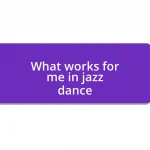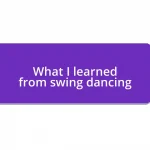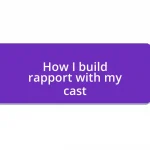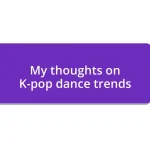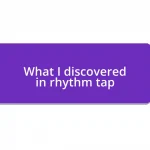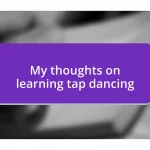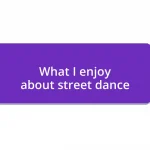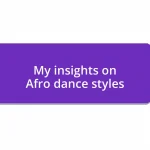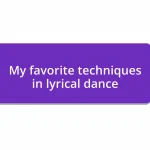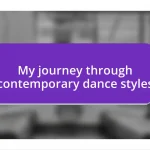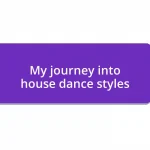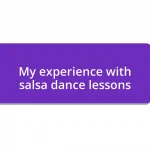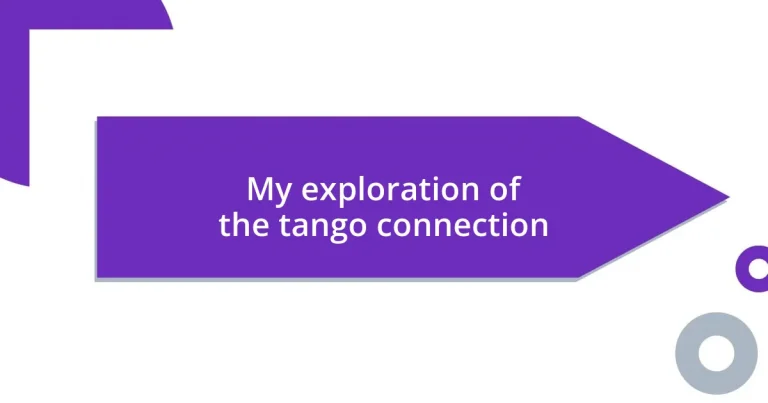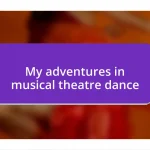Key takeaways:
- The essence of tango lies in the unspoken connection between partners, characterized by vulnerability, trust, and a shared musicality.
- Body language is crucial in tango; subtle cues like breath, posture, and eye contact enhance emotional communication and understanding between dancers.
- Practicing connection exercises, such as mirroring movements and adjusting to each other’s weight shifts, fosters a deeper bond and elevates the dance experience.
- Integrating connection into performances transforms routine choreography into an emotionally charged experience, making the dance feel like a profound dialogue between partners.
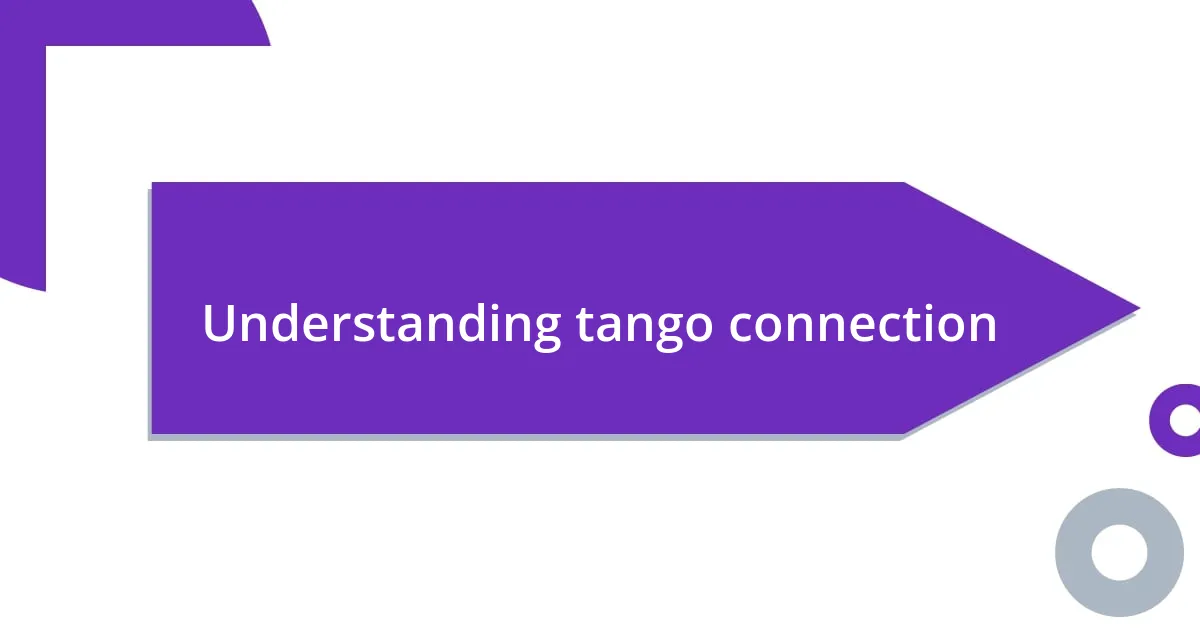
Understanding tango connection
The connection in tango goes beyond mere steps; it’s an unspoken bond between partners that breathes life into the dance. I still remember my first tango class, feeling electricity as my partner’s hand guided mine. Have you ever felt that instant click with someone? It’s a simple touch that sparks an intimacy where words fall short.
When dancing, I often reflect on how tango embodies vulnerability. Sharing that close embrace can be daunting, especially when you’re not fully in sync. But there’s something magical about surrendering to that moment, trusting your partner to lead or follow. How does it feel to let go of control and just move together? In those fleeting seconds, you discover a world of rhythm and emotion that words alone can never quite capture.
As I delve deeper into tango, I find that this connection extends into the very fabric of the music. Each note and beat resonates within me, guiding my movements and enhancing the bond I share with my partner. Have you ever found yourself lost in the music while dancing? That’s the essence of tango connection—it evolves, allowing for personal expression while uniting two souls on the dance floor.
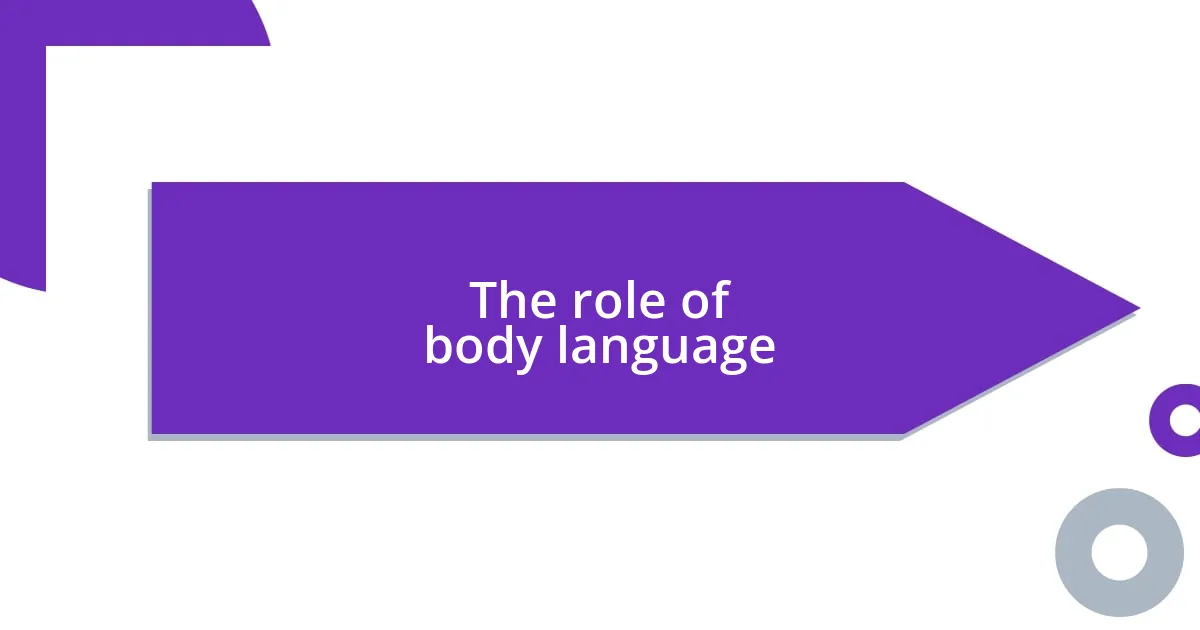
The role of body language
The way we communicate in tango is deeply rooted in body language. I’ve noticed that a slight shift in my partner’s posture or a gentle squeeze of the hand can convey feelings that words simply can’t express. This silent language creates an emotional landscape where we both instinctively know how to respond to one another.
- Feet Positioning: The angle of your feet can indicate readiness to lead or follow.
- Breath Control: A partner’s breathing rhythm can signal tension or relaxation.
- Eye Contact: Locking eyes fosters trust and connection, enhancing the shared experience.
- Embrace: The firmness or softness of the embrace can communicate comfort levels and intentions.
When I dance, I pay close attention to these subtleties. One evening, I was partnered with someone new. As we moved, a gentle nudge or a slight lean told me everything I needed to know about their intentions. That moment of understanding, created purely through body language, was exhilarating—it reminded me that every gesture, every movement holds a story waiting to be told.
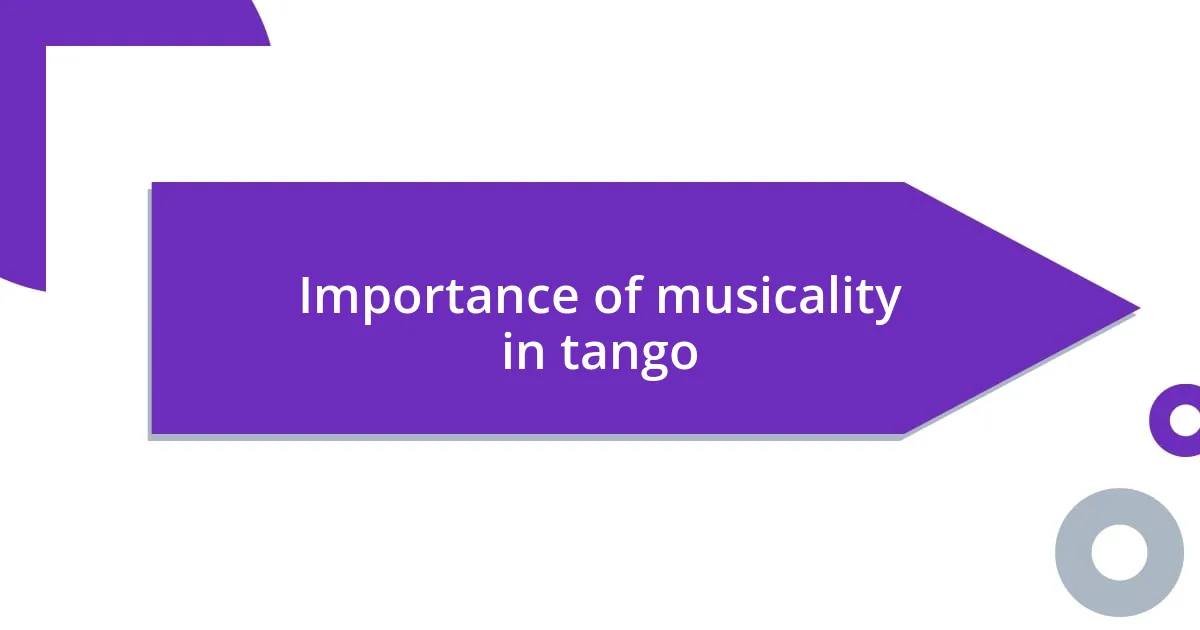
Importance of musicality in tango
Musicality in tango is fundamental to creating a vibrant dance experience. From my own journey, I’ve come to realize how understanding the music can transform the way I interpret movements. When I first started dancing tango, I was solely focused on the steps. However, once I learned to listen to the melodies and rhythms, everything changed. The music beckoned me to interpret it in unique ways, adding layers of emotion and connection to each dance.
In my experience, the nuances of the music dictate the flow and intensity of the dance. For instance, I remember a night when a slow, melancholic tune enveloped the room. It prompted me to embrace my partner more tenderly, allowing each movement to linger, reflecting the depth of the music. How often do we consider how tempo and mood dictate our choices on the dance floor? It’s this interplay between musicality and movement that elevates tango from mere steps to an expressive art form.
Lastly, musicality strengthens the partnership, creating a harmonious dialogue between dancers. I often find myself attuned to my partner’s interpretation of the music—can you sense that shared understanding while dancing? When both partners are in sync with the rhythm, every turn, every pause, resonates deeply, transforming the dance into a profound conversation full of emotion and life.
| Musical Aspect | Impact on Dance |
|---|---|
| Tempo | Dictates pace and urgency of movements |
| Rhythm | Inspires complex footwork and improvisation |
| Dynamics | Influences the energy level and emotional expression |
| Melody | Guides the flow and connection between partners |
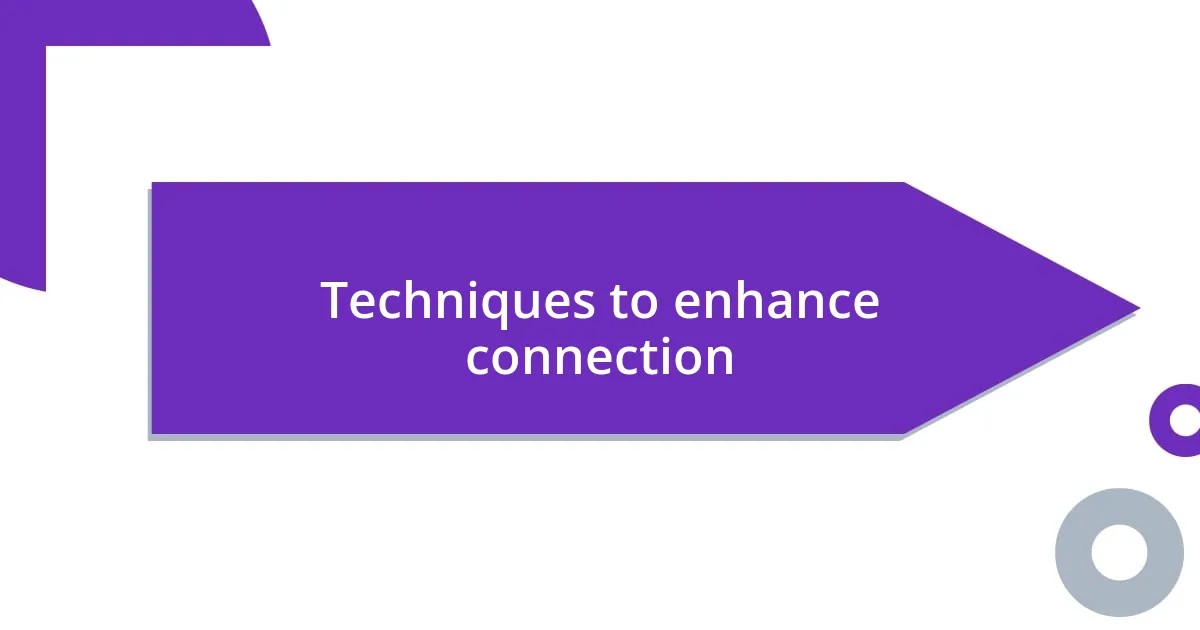
Techniques to enhance connection
Enhancing connection in tango goes beyond the basic movements; it’s about creating a dialogue between partners. One technique that I’ve found invaluable is focusing on my breath. When I consciously synchronize my breathing with my partner’s, it’s as if we create a shared rhythm that deepens our connection. Have you ever felt an instant bond with someone just by breathing together? It’s a simple yet profound way to elevate the experience.
Another effective approach involves the embrace. For me, the embrace is not just a physical hold; it’s a powerful expression of intimacy and trust. During one memorable dance, I felt the weight of my partner’s body shift as they leaned into me, and I instinctively adjusted my response. This mutual awareness transforms the dance into a form of communication where each shift and pressure tells a story. Isn’t it fascinating how a gentle squeeze can convey what words often cannot?
Finally, maintaining eye contact throughout the dance can significantly enhance the connection as well. I recall dancing in a close-knit circle where the energy pooled between us, boosted by the intensity of each gaze. When I locked eyes with my partner, it felt like we were sharing an unspoken promise to navigate the music together. This connection fosters a deeper emotional bond, allowing the dance to become more than just a series of movements. Have you ever locked eyes with someone while dancing and felt that electric spark of understanding? That moment can transform an ordinary dance into an extraordinary experience.
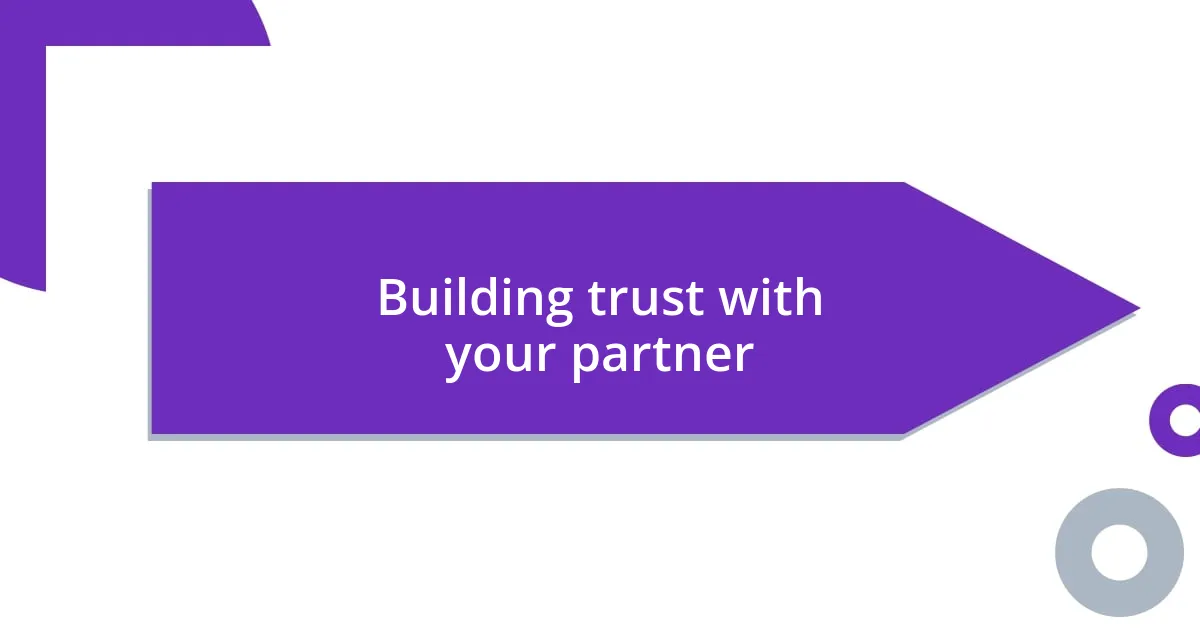
Building trust with your partner
Building trust with your partner in tango is an essential part of creating a seamless dance experience. I recall a particular evening when my partner and I tackled a complicated sequence. At first, I felt nervous, fearing I might lead us astray. However, as we began to communicate through subtle cues—like a gentle squeeze of the hand—I noticed our trust blossomed. The more I embraced those moments of vulnerability, the more confident both of us became.
Have you ever danced with someone and felt that unspoken understanding? I think that’s what trust in tango really boils down to: knowing that your partner will respond to your intentions. One night, while dancing, my partner surprised me by initiating an unexpected turn. Instead of panicking, I surrendered to the momentum and flowed with it. That leap of faith not only deepened our connection but also heightened the joy of dancing.
As I reflect on my journey, I realize that building trust is a dance within itself. It’s about letting go and truly allowing your partner to guide you at times. I remember practicing with a friend who had more experience, and how transformative it felt when I let them lead. In those moments, trusting that they had my back filled me with a sense of safety, allowing our improvisation to flourish. Isn’t it incredible how trust can elevate the dance?
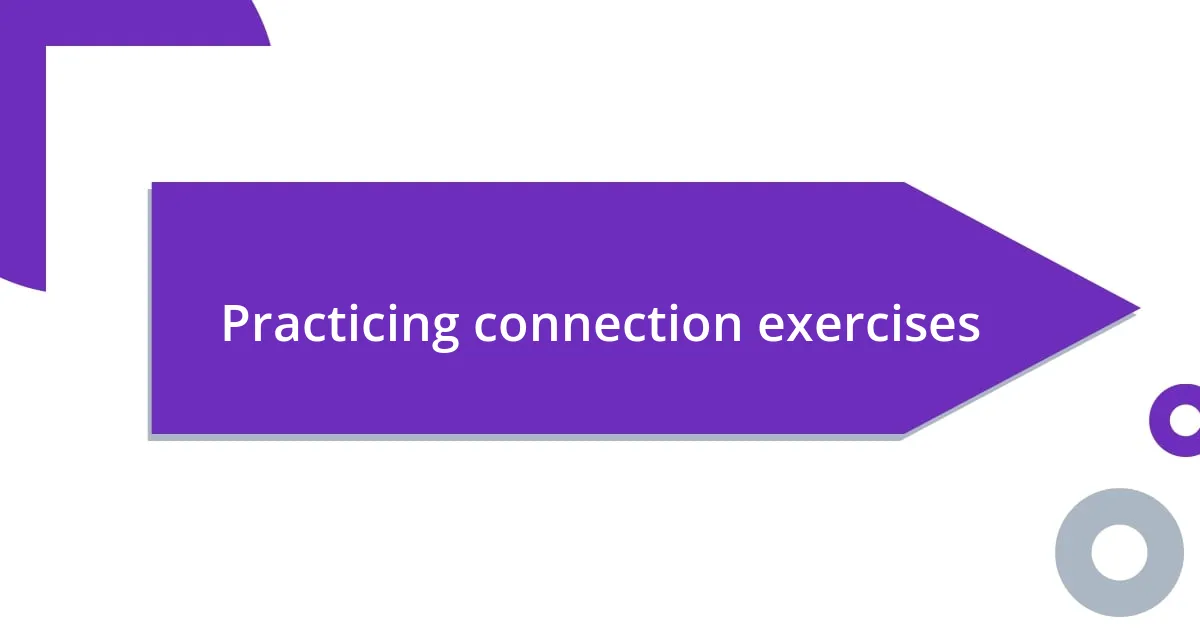
Practicing connection exercises
Practicing connection exercises in tango can take many forms, and they’ve truly been a revelation for me. I often find a partner and we’ll work on mirroring each other’s movements. It sounds simple, but when I align my steps with theirs, I feel the dance transform into a shared expression of understanding. Have you ever felt the thrill of moving in sync with someone? That moment can be pure magic.
One exercise that I cherish is the “lean in, lean away” drill. In this practice, we take turns leaning towards each other, feeling the weight shift, and then gently leaning away. I remember the first time I tried it—I felt a rush of vulnerability, as if we were both testing the waters of trust. It’s amazing how just a slight adjustment can convey a wealth of emotions and intentions. This back-and-forth creates a rhythm in itself, making you realize how responsive your partner can be when you listen closely.
Another favorite of mine is the “connect and disconnect” exercise. Here, we explore the notion of connection by briefly stepping apart and then coming back together. This juxtaposition of distance and closeness illustrates how essential it is to maintain that bond during the dance. I recall an instance where I hesitated to step back, fearing the loss of our moment. But as soon as I did, it opened a new space for creativity. Often, I find that the moments of stepping away help to solidify the connection when we’re close again. How has embracing both connection and disconnection shaped your own dance experience?
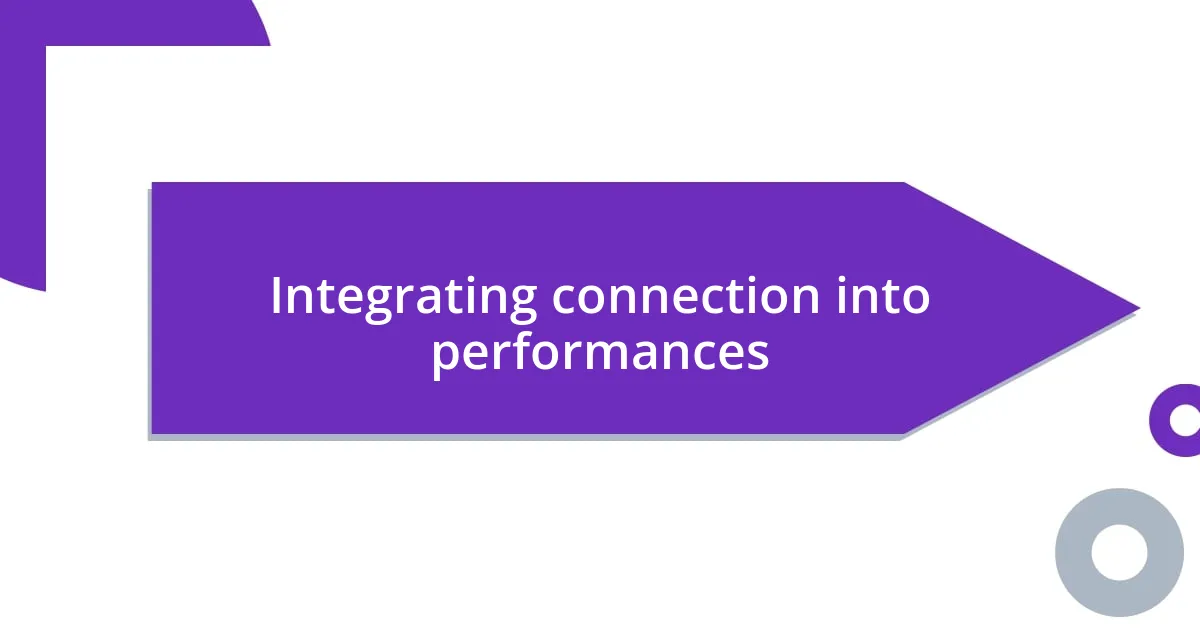
Integrating connection into performances
Integrating connection into performances is where the magic truly happens in tango. I remember performing in a small showcase, and once the music started, it felt like my partner and I were in a world of our own. It wasn’t just about the steps; it was about sensing each other’s energy and translating that into movement. Have you ever felt that rush when every twist and turn aligns perfectly? It’s euphoric, like a conversation where both partners speak and listen effortlessly.
During a performance, I often find myself mentally returning to moments of trust we’ve built during practice. I recall one evening when my partner and I locked eyes, and in that instant, we both instinctively knew when to turn and when to embrace. It’s fascinating how those silent dialogues can dictate the pace and flow of a performance. How often do we recognize the power of a simple glance? That connection can elevate an ordinary dance into something profound, weaving the audience into our experience.
While the choreography is essential, I have come to realize that the connection we share fuels the emotion in our performance. I’ll never forget one particular performance where I felt a surge of uncertainty before stepping onto the floor. However, as soon as I took my partner’s hand, that worry melted away. The way we moved together was as much about feelings as it was about technique. It reminded me that it’s not just about showcasing our skill but sharing a deeper bond through the art of tango. Isn’t it beautiful how connection transforms something technical into an emotionally charged experience?
